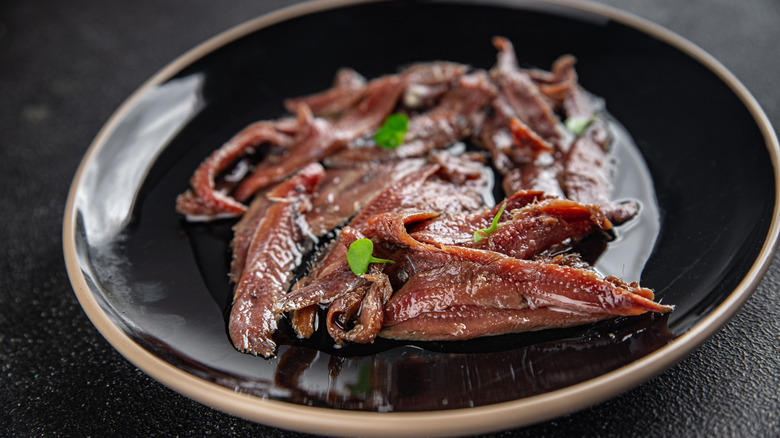The Unexpected Ingredient Worcestershire Sauce And Caesar Dressing Have In Common
Crafting a truly mouthwatering sauce involves a dash of culinary magic. And oftentimes, such wondrous enhancement comes by way of umami-rich ingredients. For instance, cooked tomatoes lend a hefty dose to ketchup, soy sauce ups teriyaki's savory composition, and — unexpectedly — anchovies provide the umami in Worcestershire Sauce and the best basic Caesar dressing.
You might not associate these staples with seafood, but fish functions as a cornerstone of their composition. To prepare Worcestershire sauce, anchovies ferment in vinegar for as long as 18 months, transforming into a predominantly umami-flavored foundation. Meanwhile, a Caesar dressing finely chops oil-packed anchovies into a paste-like form. Used in moderation, the ingredient doesn't make the salad taste fishy, but rather uplifts the dish with meatiness and brine-like saltiness.
Intriguingly, the two culinary creations further intertwine; original renditions of Caesar dressing employed Worcestershire sauce. Some Caesar dressing recipes still incorporate anchovies and Worcestershire sauce together. Pairing multiple umami-rich ingredients escalates savoriness — so add a dash of parmesan for good measure, too. Umami makes a sauce shine, especially when delivered in anchovy form.
Anchovies intertwine many umami-rich sauces
Although umami's existence was only scientifically confirmed in the early 20th century, the savory powers of anchovies have been employed for centuries. Before fish sauce proliferated into its many varieties across Southeast Asia, several remarkably similar fermented sauces appeared in the Roman Empire. Using varying small fish and production methods, the aim remained constant: to craft a super-savory, easy-to-use seasoning in liquid form.
Centuries later, in 1837, the bizarre invention of Worcestershire sauce continued such a fish-liquid legacy, only sold to the British market from a pharmacy — manned by chemists John Wheeley Lea and William Henry Perrins (yes, that Lea & Perrins). The condiment then appeared in the first Caesar salad, created in 1924 in Tijuana, Mexico. It's believed Caesar Cardini synthesized the modern classic, but many cite it was his brother who first innovatively folded anchovies into the mix. Regardless, the timeline evinces anchovy's centrality to these sauces — the fish is hardly a funky curveball.
Furthermore, the anchovy's flavor-packed power surfaces in other sauces, too. Paired with garlic, capers, and parsley, it makes for a delectable, zesty steak sauce – or it can be folded into a wondrously rich compound butter. You'll find the fish in the mouth-watering Italian Bagna Cauda sauce, a warmed mixture of anchovy and garlic meant for dipping. Not to mention, there are delicious anchovy-mustard vinaigrettes without Caesar's creaminess, as well as other bottled British seasonings like Geo Watkins Anchovy Sauce. So next time you hear of anchovies in your sauce, don't be surprised — the foodstuff's an umami powerhouse.


